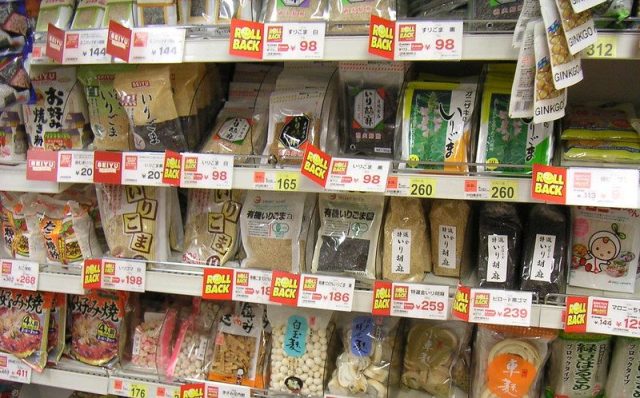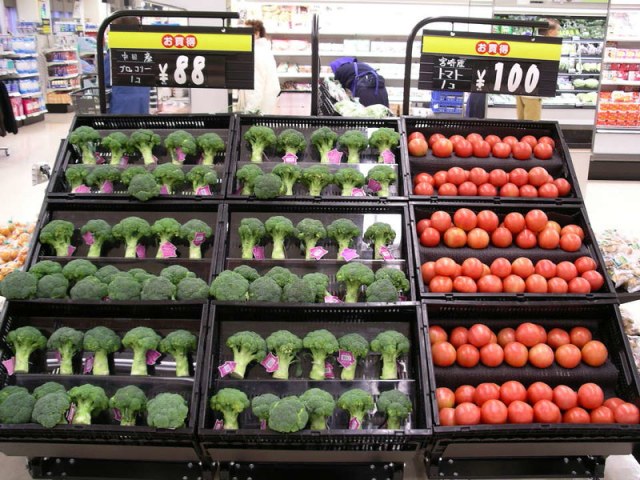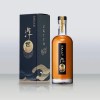
Seiyu might be setting a precedent with their easily stackable product tubs.
Aestheticism is highly prized in Japan. From the daintiest ribbon-wrapped Coke bottle to the broad, clean streets, how things look is just about as important as how they operate.
For a great example of this in action, just look at the majority of Japanese supermarkets. You’ll find pristine racks of products lined in single file, and they’ll be reorganized right away when a customer disrupts the presentation by removing something.
▼ Regimented rows of vegetables at a supermarket.
But… is it necessary to put such importance on aesthetics at a supermarket? One Seiyu supermarket store is taking a stand.
▼ “This is really true. More supermarkets should follow suit.” (Sign translation below)
ほんまこれやからまじでどこのスーパーも見習うべき。 pic.twitter.com/5nHRnscRJA
— とまとにんじん。 (@jp_tomato) January 8, 2020
The sign pictured reads:
“We stack our shelves for efficiency rather than attractiveness.
The rows of cup ramen and snack baskets may look as though they have been thrown together haphazardly. However we find that stacking them in this way drastically increases our efficiency. This helps us to offer you products at such low prices.”
The user who posted the picture clearly feels strongly about this method, as they went on to outline many of the arguments about stacking in this way — and then rebutted each one in turn.
“‘It’s hard to see the best before date.’
Do you really need to see each date, when most items from a shipment will have the same one?”“‘If you don’t stack them neatly, it’s hard to see the packaging.’
You can’t see the top or bottom of most neatly packed products either, and if you take one out to check and then decide to put it back, you have to make sure it looks good.”“‘The value of products will decline if they’re stacked like this.’
Just like Seiyu said in their announcement, this stacking rule only applies to snacks and cup ramen (though it wouldn’t especially bother me anyway.)”“‘It’ll be a pain to take stock of the products.’
What if you just used a bunch of grocery carts while taking stock, filled them with the total amount of one item, and then throw them into the display basket as you inspect them?”“‘I hate how messy this kind of display looks so I never buy products stacked like this.’
To each their own. No one is saying you have to shop at supermarkets that stack like this.”
Then, to demonstrate against the argument for package visibility, they posted this follow-up image.
▼ (Translation below)
・乱雑に入れてあるとパッケージが見にくい
— とまとにんじん。 (@jp_tomato) January 9, 2020
同スーパーで綺麗に積まれた写真を頂きました。コンビニのように上部が正面に無く余計に見にくいとわたくしは感じる。乱雑に入れられていると多方向が自然と見えるのでは?そもそも定番商品の場合パッケージを見ずに値段だけ見て買う事の方が多い気がする。 pic.twitter.com/ICC8QaUuIn
“I took a photo from the same supermarket of the products stacked together nicely. I feel like you still can’t see the top of the packaging, just like how they’re packed in a convenience store. But if they’re all jumbled together, they face in all kinds of directions, right? So you’re more likely to see the package. Anyway, with regular products like this I feel like more people buy it after checking the price without even glancing at the package.”
There was a considerable amount of backlash from some commenters, who insisted that taking that extra time and care to make things look presentable is part of the Japanese spirit, and it’s a sad thing to see it passed over in favor of efficiency. Others compared Seiyu’s messy shelves to other well-known budget stores like Don Quijote, while others said “it looks like a supermarket from abroad”.
Those last commenters might be onto something. You see, the majority of shares in Seiyu are owned by an American retailer: Wal-Mart.
For what it’s worth, more than one commenter said “I think it looks better stacked in a jumble”. Beauty really is in the eye of the beholder!
Source: Twitter/@jp_tomato via My Game News Flash
Featured image: Flickr/Brand New Films
Insert image: Flickr/Jacob Levine
● Want to hear about SoraNews24’s latest articles as soon as they’re published? Follow us on Facebook and Twitter!


 The next must-have item for game fans: Adorable stackable Kirbys!
The next must-have item for game fans: Adorable stackable Kirbys! Here are Japan’s favorite ice creams from last month! Vanilla wins by a mile…
Here are Japan’s favorite ice creams from last month! Vanilla wins by a mile… Japanese police face criticism for improper handling of stolen Pokémon and Yu-Gi-Oh cards【Video】
Japanese police face criticism for improper handling of stolen Pokémon and Yu-Gi-Oh cards【Video】 Japanese convenience store or Japanese supermarket: Which one is cheaper?
Japanese convenience store or Japanese supermarket: Which one is cheaper? Japanese confectionary chain Chateraise opens first 24-hour branch with self-checkout
Japanese confectionary chain Chateraise opens first 24-hour branch with self-checkout Secret hot spring onsen in Japan is a hidden gem waiting to be discovered by tourists
Secret hot spring onsen in Japan is a hidden gem waiting to be discovered by tourists A trip to see the breathtaking mountain beauty of Nagano’s Kamikochi【Part 1】
A trip to see the breathtaking mountain beauty of Nagano’s Kamikochi【Part 1】 Does Starbucks Japan’s new holiday Frappuccino really taste like a cup of fallen snow?
Does Starbucks Japan’s new holiday Frappuccino really taste like a cup of fallen snow? Japanese samurai randoseru backpack lets you carry the bushido spirit with you wherever you go
Japanese samurai randoseru backpack lets you carry the bushido spirit with you wherever you go Japanese Prime Minister once criticized deploying military to fight Godzilla
Japanese Prime Minister once criticized deploying military to fight Godzilla New heater-less pet kotatsu is a safe way to keep your furry friends warm this winter
New heater-less pet kotatsu is a safe way to keep your furry friends warm this winter Pokémon doughnuts appear at Mister Donut, with Diglett as the star!
Pokémon doughnuts appear at Mister Donut, with Diglett as the star! Dark and edgy Jujustu Kaisen teams up with bright and cheery Sanrio for new merch line【Pics】
Dark and edgy Jujustu Kaisen teams up with bright and cheery Sanrio for new merch line【Pics】 Japan Weak Men’s Center suddenly cancels men-only train event
Japan Weak Men’s Center suddenly cancels men-only train event Sip with Snorlax – Clever drinkware design creates Pokémon in your glass with every pour【Pics】
Sip with Snorlax – Clever drinkware design creates Pokémon in your glass with every pour【Pics】 Nintendo’s controller capsule toys are so cool, even the machine you buy them from is awesome【Pics】
Nintendo’s controller capsule toys are so cool, even the machine you buy them from is awesome【Pics】 American gun owner opens our eyes to a different way of life in Tokyo
American gun owner opens our eyes to a different way of life in Tokyo Japanese communities giving their skylines a spring clean and saying goodbye to power lines
Japanese communities giving their skylines a spring clean and saying goodbye to power lines New Akita Inu and Hachiko marshmallows are the best and squishiest souvenirs from Japan
New Akita Inu and Hachiko marshmallows are the best and squishiest souvenirs from Japan Burger King Japan creates Kyoto Whopper, its most Japanese burger ever, with Kyoto rice merchant
Burger King Japan creates Kyoto Whopper, its most Japanese burger ever, with Kyoto rice merchant Starbucks Japan unveils new Holiday goods for 2024
Starbucks Japan unveils new Holiday goods for 2024 Totoro stamp collection lets you add adorable Ghibli touches to cards and letters【Photos】
Totoro stamp collection lets you add adorable Ghibli touches to cards and letters【Photos】 Overwhelmed by modern social media? Japanese company is bringing back pagers with an emoji-twist
Overwhelmed by modern social media? Japanese company is bringing back pagers with an emoji-twist Discovered: An even better way to open Japanese convenience store rice balls【Video】
Discovered: An even better way to open Japanese convenience store rice balls【Video】 Studio Ghibli releases new insect whistle necklace from Nausicaä of the Valley of the Wind
Studio Ghibli releases new insect whistle necklace from Nausicaä of the Valley of the Wind Totoro sequel anime Mei and the Baby Catbus will screen at Ghibli Park this winter
Totoro sequel anime Mei and the Baby Catbus will screen at Ghibli Park this winter Tokyo Disneyland loses top-attendance crown for Japanese theme parks for second year in a row
Tokyo Disneyland loses top-attendance crown for Japanese theme parks for second year in a row Starbucks Japan unveils Halloween Frappuccino for 2024, and it’s like drinking a magic spell
Starbucks Japan unveils Halloween Frappuccino for 2024, and it’s like drinking a magic spell Evangelion creator Hideaki Anno returning to anime with new project for 50-year-old franchise
Evangelion creator Hideaki Anno returning to anime with new project for 50-year-old franchise Studio Ghibli releases new Howl’s Moving Castle goods that capture the magic from the anime movie
Studio Ghibli releases new Howl’s Moving Castle goods that capture the magic from the anime movie Adult Jam Bread causes a stir at store in Tokyo
Adult Jam Bread causes a stir at store in Tokyo What’s the deal with akebi, the perfectly purple, alien-like fruit that’s in season now in Japan?
What’s the deal with akebi, the perfectly purple, alien-like fruit that’s in season now in Japan? Kyoto becomes City of Yokai, with Night Parade of One Hundred Demons festival this autumn
Kyoto becomes City of Yokai, with Night Parade of One Hundred Demons festival this autumn McDonald’s new Happy Meals offer up cute and practical Sanrio lifestyle goods
McDonald’s new Happy Meals offer up cute and practical Sanrio lifestyle goods Foreign tourists on Shinkansen bullet train break suitcase etiquette, angering local passengers
Foreign tourists on Shinkansen bullet train break suitcase etiquette, angering local passengers [Deleted] Article written for April Fool’s Day 2018
[Deleted] Article written for April Fool’s Day 2018 Japanese government to make first change to romanization spelling rules since the 1950s
Japanese government to make first change to romanization spelling rules since the 1950s Foreigner’s request for help in Tokyo makes us sad for the state of society
Foreigner’s request for help in Tokyo makes us sad for the state of society Ghibli founders Toshio Suzuki and Hayao Miyazaki contribute to Japanese whisky Totoro label design
Ghibli founders Toshio Suzuki and Hayao Miyazaki contribute to Japanese whisky Totoro label design Japanese convenience store Family Mart announces abolishment of eat-in spaces
Japanese convenience store Family Mart announces abolishment of eat-in spaces Princesses, fruits, and blacksmiths: Study reveals the 30 most unusual family names in Japan
Princesses, fruits, and blacksmiths: Study reveals the 30 most unusual family names in Japan Doraemon found buried at sea as scene from 1993 anime becomes real life【Photos】
Doraemon found buried at sea as scene from 1993 anime becomes real life【Photos】 Life-size vibrating Legend of Zelda Master Sword for sale from Nintendo【Photos】
Life-size vibrating Legend of Zelda Master Sword for sale from Nintendo【Photos】 Japan has more anime/video game actresses than ever before, according to major seiyu magazine
Japan has more anime/video game actresses than ever before, according to major seiyu magazine The Japanese art of making trash containers from old papers
The Japanese art of making trash containers from old papers This is what a Whopper with 1,005 slices of cheese looks like in today’s financial climate
This is what a Whopper with 1,005 slices of cheese looks like in today’s financial climate We sample the Super Cup 1.5 times x Yoasobi collaboration cup ramen that’s now on sale
We sample the Super Cup 1.5 times x Yoasobi collaboration cup ramen that’s now on sale These new Cardcaptor Sakura basket purses are just as cute as Sakura herself
These new Cardcaptor Sakura basket purses are just as cute as Sakura herself Tokyo bento shop famous for jumbo orders offers a meaty sausage lunch for under 1,000 yen
Tokyo bento shop famous for jumbo orders offers a meaty sausage lunch for under 1,000 yen Japan continues to shun processed fish sticks, opts for minimally processed fish cubes instead
Japan continues to shun processed fish sticks, opts for minimally processed fish cubes instead We travel to Fuji to see how they make Japanese toilet paper
We travel to Fuji to see how they make Japanese toilet paper Amazingly organized Sailor Moon treasure drawer is inspiration to anime fans and neat freaks【Vid】
Amazingly organized Sailor Moon treasure drawer is inspiration to anime fans and neat freaks【Vid】 A cup ramen for Zen Buddhists: New Shindo Ramen Zendo noodles are meat, dairy and egg free
A cup ramen for Zen Buddhists: New Shindo Ramen Zendo noodles are meat, dairy and egg free The mesmerizing art of stacking Japanese coins 【Photos】
The mesmerizing art of stacking Japanese coins 【Photos】 We buy a sushi-restaurant-themed bath bomb that threatens to smell like the ocean
We buy a sushi-restaurant-themed bath bomb that threatens to smell like the ocean Japanese Twitter user spends eight years stacking toilet paper cores, completes entire wall
Japanese Twitter user spends eight years stacking toilet paper cores, completes entire wall Mini karate-chop roof tiles you can actually destroy are Japan’s newest capsule toy【Videos】
Mini karate-chop roof tiles you can actually destroy are Japan’s newest capsule toy【Videos】 Sega begins Puyo Puyo Boot Camp to help bring eSports into more Japanese high schools
Sega begins Puyo Puyo Boot Camp to help bring eSports into more Japanese high schools Penguin Bomb papercraft is the most amazing thing you’ll see today【Video】
Penguin Bomb papercraft is the most amazing thing you’ll see today【Video】
Leave a Reply